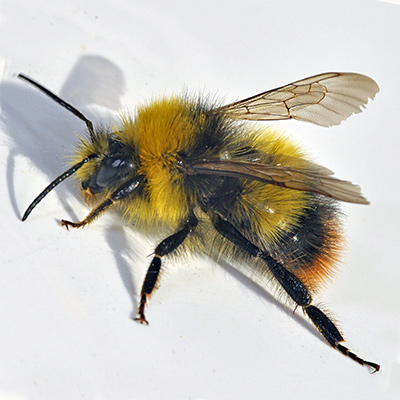
 |
|
Scientific Classifications explained » Amphibians » Ants » Aphids » Bees » Beetles » Birds » Bugs » Butterflies » Caterpillars » Damselflies » Dragonflies » Earwigs » Flies » Frog/Leafhoppers » Fungi » Galls » Grasshoppers » Harvestmen » Hoverflies » Lacewings » Ladybirds » Leaf Mines » Lichens » Mammals » Millipedes » Mosses » Moths » Sawflies » Slugs » Snails » Spiders » Trees & Shrubs » Wasps » Wild Flowers » Woodlice » Postboxes |
UK Nature > Bees > Bombus pratorum

Scientific Name: Bombus pratorum Common Name: Early Bumblebee Bombus pratorum, more commonly known as the Early Bumblebee, is one of the smaller species of bumblebee, the queen is up to 17 mm in length and has a wingspan of up to 32 mm. The front part of the thorax is covered with yellow hairs, even though the thorax may be covered with yellow hairs entirely, especially in males. The hairs however are always brightly yellow and do not tend to be brown as in the case of the Common Carder Bee (Bombus pascuorum). Often the first part of the abdomen is yellow as well, but the yellow hairs may be absent here. The tail is strikingly orange. Bombus pratorum is not the earliest species seen in the year; the bigger Bombus terrestris sometimes flies by the end of February, while most Early Bumblebees start looking for a nest in the middle of March. Will visit a wide range of flowers and can be found almost everywhere: meadows, gardens, parks and the edges of forests. A very common species all over the British Isles. |
|

https://www.uknature.co.uk is a website dedicated to showing the immense diversity of UK nature and wildlife. Our vast range of habitats, from lowland arable to snow covered mountains, from storm-ravaged coastlines to peaceful inland freshwater lakes and rivers, from dry, sandy heaths to deciduous and coniferous forests, all these habitats contribute to the abundance of UK nature. We have wild birds in huge numbers either residing or visiting our shores (597 recorded species as at July 2013) and we must also not forget the humble back garden with its grass lawns, flower beds filled with nectar rich flowers, shrubs and trees, all designed to attract huge numbers of insects such as bees, moths, butterflies and hoverflies; and finally the small ponds which provide safe havens for frogs, toads, newts and even slow worms and grass snakes. www.uknature.co.uk is the showcase for my personal passion, photographing uknature in all its glory. I sincerely hope you all enjoy the fruits of my labours. This site and all images contained therein is © Jeremy Lee 2004 - 2025. All Rights Reserved. Site design by Jeremy Lee. Site development & IT Support by Stuart Lee. |